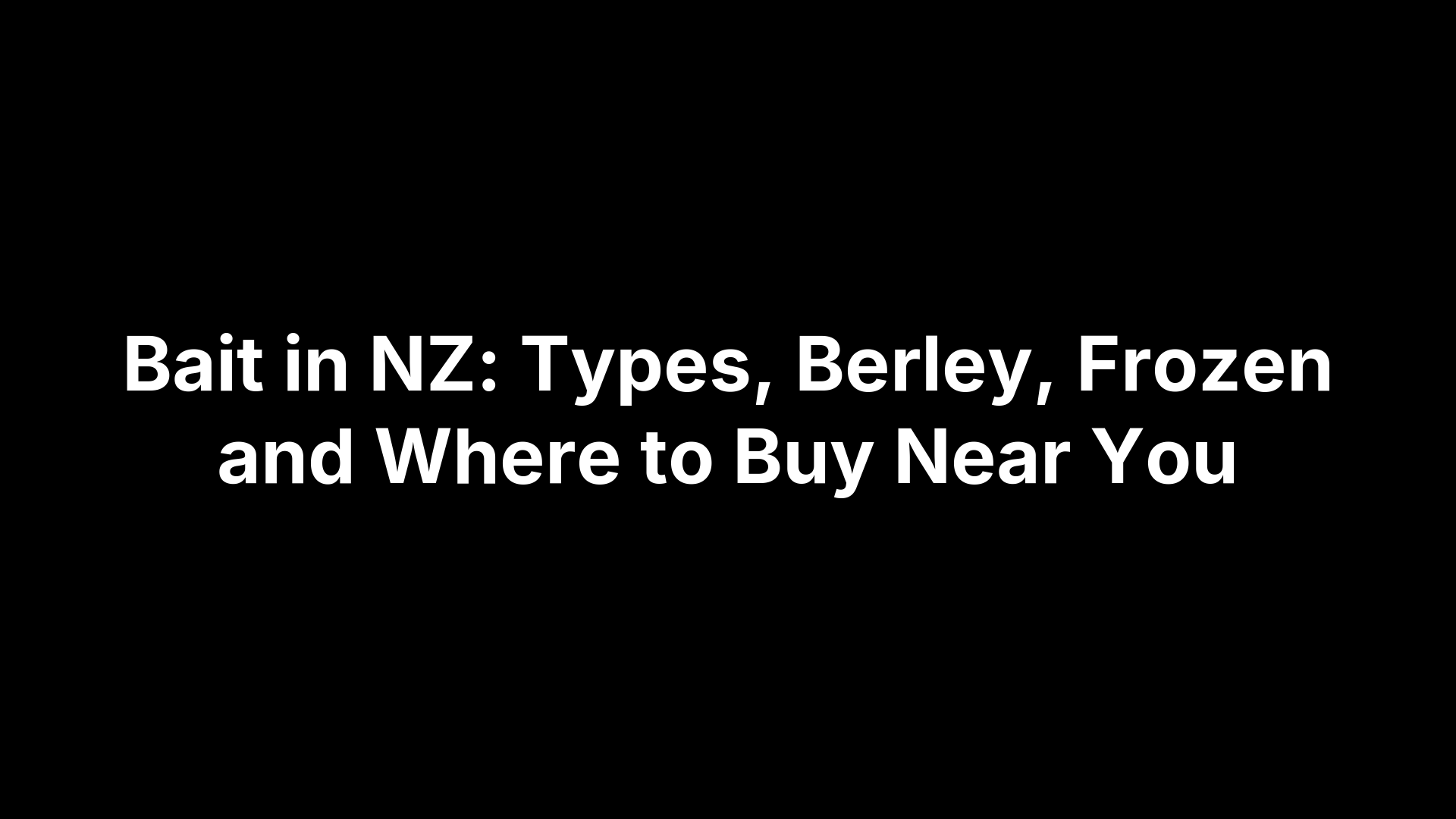Bait in NZ: Types, Berley, Frozen and Where to Buy Near You
Bait is what gets fish interested enough to bite. You attach it to your hook or spread it in the water to attract your target species. In New Zealand waters, the right bait can mean the difference between a full chiller bin and going home empty handed. Fresh pilchards work brilliantly for snapper. Squid tempts kingfish. Berley brings schools closer to your boat or shore position.
This guide covers everything you need to know about buying and using bait around New Zealand. You'll learn which types work best for specific fish, where to source frozen and fresh options locally, and how berley improves your catch rates. We'll also walk you through the rules around catching your own bait and staying within legal limits. Whether you fish from a boat, kayak, or off the rocks, having the right bait ready makes your time on the water more productive.
Why bait choice matters in New Zealand waters
New Zealand's diverse marine environment means fish species have developed specific feeding patterns and preferences. Your bait selection directly affects whether you attract snapper lurking near rocky reefs or kingfish cruising open water channels. Each species has evolved to hunt particular prey, and matching your bait to their natural diet triggers their feeding response. Using the wrong bait wastes time and money while you sit waiting for bites that never come.
Water temperature, clarity, and current strength all influence how fish detect and respond to different baits. Oily baits like pilchards release scent trails that work brilliantly in murky harbour waters where visibility is limited. Clear oceanic conditions often require fresh, whole baits that look natural and move realistically. Frozen baits stored incorrectly lose their scent and texture, becoming far less effective at attracting fish. You need bait that stays on your hook through strong currents and resists attack from smaller nuisance species.
Fresh bait that matches local prey species consistently outperforms generic frozen options in competitive fishing situations.
Local regulations also govern which bait species you can collect and use in different regions. Some areas restrict taking undersized fish for bait, while others prohibit using certain protected species entirely. Knowing these rules keeps you legal and helps preserve fish stocks for future generations of anglers.
How to choose the right bait for your target fish
Understanding your target species' natural diet gives you the best starting point for bait selection. Snapper feed heavily on shellfish, crustaceans, and small fish around rocky reefs and sandy bottoms, so pilchards, squid, and fresh mullet work exceptionally well. Kingfish chase fast-moving prey like mackerel and kahawai in open water, making live or fresh whole baits your most effective option. Research what your target fish naturally eats in your local area before heading out.
Match bait to feeding habits
Bottom feeders like gurnard and tarakihi respond best to baits that sit on the seabed and release strong scent trails through the water column. Cut pilchards, squid strips, and shellfish meat work brilliantly for these species. Pelagic hunters such as kingfish and trevally prefer baits that move naturally through the water, either as live offerings or fresh dead baits rigged to swim realistically. You'll catch more fish when your bait mimics how they naturally hunt and feed.
Fish commit to striking baits that match both the size and movement patterns of their regular prey.
Consider water conditions and location
Murky harbour waters require oily, strong-scented baits like pilchards or mullet that fish can locate through smell rather than sight. Clear oceanic conditions allow you to use less pungent options such as fresh squid or whole fish that look natural and appealing. Depth also influences your choice, as baits need to reach the bottom intact in deep water without getting stripped by smaller fish on the way down. Strong currents demand tougher baits that stay on your hook.
Size and presentation matter
Match your bait size to both your hook and target species. A whole pilchard works perfectly for snapper but overwhelms smaller species like kahawai. Cut your bait into appropriate portions that fit your hook size while still releasing enough scent to attract fish. Larger predators like kingfish require substantial baits that justify the energy they expend chasing and attacking. Your presentation method (whole, filleted, or chunked) affects how long the bait stays effective and how fish respond to it.
Main types of bait, berley and frozen options
New Zealand tackle shops and marine suppliers stock several bait categories that serve different fishing situations and target species. Fresh whole baits provide maximum scent and visual appeal but require careful storage and quick use. Frozen options offer convenience and longer shelf life while maintaining effectiveness for most species. Understanding what each type delivers helps you stock your esky with the right combination for your fishing trip.
Fresh whole baits
Pilchards remain the most popular fresh bait across New Zealand waters because they work for almost every target species from snapper to kingfish. You'll find them sold in various sizes, with smaller ones perfect for kahawai and larger specimens ideal for snapper fishing. Fresh mullet caught from estuaries produces excellent results for big snapper around rocky areas and makes deadly live bait for kingfish when properly rigged. Mackerel and koheru work brilliantly as cut or whole baits, particularly for offshore species that respond to oily fish scent trails.
Fresh whole baits that still show clear eyes and firm flesh consistently outperform frozen alternatives in side-by-side comparisons.
Squid offers versatility because you can use it whole for larger fish or cut it into strips for smaller species. Fresh squid stays on hooks better than frozen versions and releases a strong scent that travels far through the water column. Your local fish market often stocks fresh squid at reasonable prices, and you can portion it yourself to suit different hook sizes and target species.
Cut baits and fillets
Cutting your bait into appropriate sizes stretches your supply further while matching the feeding habits of different species. Pilchard fillets work perfectly for smaller reef fish like tarakihi and gurnard, while chunked skipjack or bonito attracts larger predators in deeper water. You control the scent release by how you cut your bait, with more cuts exposing more flesh and producing stronger attraction.
Salted baits prepared from fresh fish give you the benefits of preserved bait with improved toughness. Salt draws moisture out and firms up the flesh, making it resist smaller fish attacks and stay on your hook through multiple casts. This method works particularly well with mullet, kahawai, and skipjack when you want bait that lasts longer in strong currents or rough conditions.
Berley options for attracting fish
Berley creates a scent trail that draws fish from considerable distances to your fishing location. Commercial berley mixes combine fish oils, ground pilchards, and additives that dissolve slowly in water, releasing attraction over extended periods. You can make your own berley by mincing old bait, adding bread or pollard as a binding agent, and mixing in tuna oil for extra scent.
Pellet berley offers convenience for boat and kayak fishers because it stores easily and dispenses in controlled amounts. Release berley gradually rather than dumping large quantities at once, as a steady stream keeps fish interested and moving toward your baited hooks. Different depths require different berley strategies, with floating mixes working for surface feeders and weighted bags delivering scent to bottom dwellers.
Frozen bait advantages
Frozen pilchards stocked in bulk let you prepare for multiple fishing trips without worrying about bait spoilage between outings. Quality frozen bait maintains around 80% of fresh bait effectiveness when properly thawed and handled. Your freezer becomes a bait store that's always ready, eliminating last-minute dashes to tackle shops before dawn departures.
Vacuum-packed frozen baits preserve quality better than loose-frozen options by preventing freezer burn and oxidation. Thaw frozen bait slowly in your chiller bin rather than leaving it in direct sunlight, as gradual thawing maintains better texture and scent. Specialized frozen baits like whole squid, octopus, and skipjack tuna give you access to options that might not be available fresh in your area.
Where to buy bait and berley near you in NZ
Tackle shops and marine supply stores stock the widest range of fresh and frozen bait options throughout New Zealand. These retailers understand local fishing conditions and carry baits that work for your regional target species. You'll find them in most coastal towns and major cities, often located near boat ramps and popular fishing spots where you can grab bait on your way to the water. Store staff typically fish themselves and provide valuable advice about which baits currently produce the best results in your area.
Local tackle and marine stores
Physical retail stores let you inspect bait quality before purchasing, which matters when fresh bait determines your fishing success. Action Outdoors in Auckland stocks comprehensive fishing tackle and accessories for anglers targeting different species across New Zealand waters. Coastal regions feature specialized marine suppliers that focus on commercial-grade bait for charter operations and serious recreational fishers. These stores often receive fresh bait deliveries multiple times weekly and maintain proper cold storage to preserve quality.
Establishing relationships with local tackle shop staff gives you insider knowledge about seasonal bait patterns and recent fishing success.
Online suppliers and delivery options
Online bait retailers deliver frozen options directly to your door, letting you stock up without visiting physical stores. Hunting and Fishing New Zealand operates both retail locations and an online platform carrying various bait and berley products. Bulk frozen bait purchases online typically cost less per kilogram than buying small quantities from shops, making this approach economical for regular fishers who maintain home freezers stocked with multiple bait types.
Fish legally and sustainably when using bait in NZ
New Zealand fishing regulations protect fish stocks and marine ecosystems by setting clear rules around bait collection and use. You must follow daily catch limits when collecting your own bait species such as piper, mackerel, or kahawai. These limits apply whether you catch fish for eating or for bait, and exceeding them results in significant fines that affect your fishing privileges. Understanding these rules keeps you legal while supporting healthy fish populations for future generations of anglers.
Know your collection limits
Each bait species has specific daily limits that vary by region and season throughout New Zealand. You cannot take undersized fish for bait, as minimum size restrictions apply regardless of whether you plan to eat or use them as bait. Regional councils and Fisheries New Zealand set these limits based on scientific stock assessments and sustainability goals. Check current regulations for your fishing area before collecting any bait species, as rules change based on population health and environmental conditions.
Following bait collection limits directly contributes to maintaining healthy fish stocks that support both recreational and commercial fishing across New Zealand.
Protect spawning seasons and protected areas
Avoid collecting bait during peak spawning periods when fish gather in large numbers to reproduce. Taking bait fish during these critical times removes individuals before they contribute to the next generation. Marine reserves and protected areas prohibit all bait collection to preserve biodiversity and allow fish populations to recover. Respect these boundaries even when you see abundant bait fish inside protected zones, as removing them undermines conservation efforts that benefit all fishers long term.
Final thoughts
Choosing the right bait transforms your fishing success across New Zealand waters. Fresh options attract more fish when properly stored and matched to your target species. Berley keeps them interested while you present your baited hooks. Stock your esky with quality frozen alternatives between trips, and always respect collection limits that protect our fisheries. If you're catching your own bait fish, explore our durable fishing nets for NZ waters to ensure you gather bait efficiently and legally.

